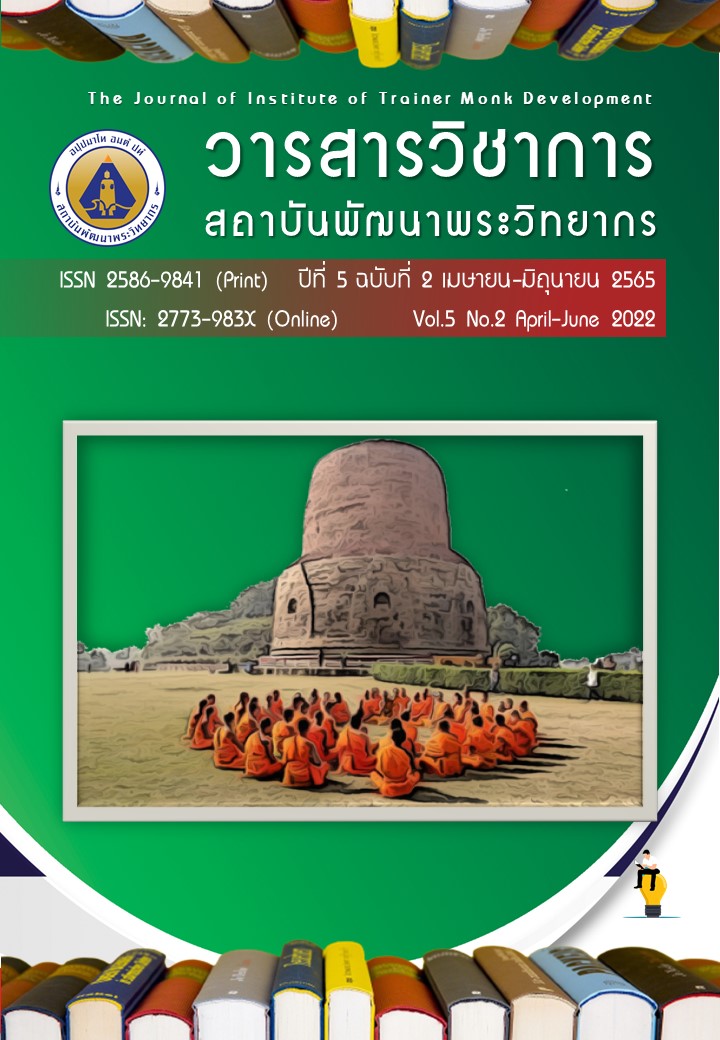The Power of Buddhist Young Volunteers for Fake News Alerts in the Digital Age
Main Article Content
Abstract
The research article consisted of the following objectives: 1) to investigate the processes of cultivating fake news alerts on Buddhism among Buddhist young volunteers in the digital age; 2) to take lessons learned from activities involving the power of Buddhist young volunteers for fake new alerts in the digital age; and 3) to explore the suitable guidelines on the power of Buddhist young volunteers for fake new alerts in the digital age. A qualitative research method was used in the study. The data collection tools for the study included an in-depth interview form, an observation form, and guidelines for focus group discussions. From the study, the following results are found:
1) The processes of cultivating fake news alerts on Buddhism among Buddhist young volunteers in the digital age include the processes of threatening and dealing with fake news creators, producing fake news, and examining fake news.
2) Through the after-action review (AAR), the lessons learned were drawn from activities involving the power of Buddhist young volunteers for fake new alerts in the digital age as follows:
The first process is "Threatening and dealing with fake news," which allows participants to learn about the network of social and digital media, as well as the origin, goals, and harm caused by fake news.
The second process is "Fake news creators," which allows participants to learn about the techniques used to create fake news, enabling them with critical thinking skills in creating fake news and allowing them to apply the skills as media consumption tools.
The third process is "Techniques for Examining Fake News," which teaches participants how to examine fake news using Buddhist teachings such as Kālāmasutta (advice on how to investigate doubtful matters) and Yonisomasikāra (thorough attention).
3) The suitable guidelines on the power of Buddhist young volunteers for fake new alerts in the digital age are: (1) The guidelines for fake news alerts in the digital age; (2) The process of cultivating fake news alerts; and (3) The guidelines for screening fake news. Keywords: Alert; Fake News; Young Buddhists.
Article Details

This work is licensed under a Creative Commons Attribution-NonCommercial-NoDerivatives 4.0 International License.
บทความที่ได้รับการตีพิมพ์เป็นลิขสิทธิ์ของวารสารวิชาการสถาบันพัฒนาพระวิทยากร
ข้อความที่ปรากฎอยู่ในบทความที่ได้รับการตีพิมพ์ในวารสาร ถือเป็นความรับผิดชอบของผู้เขียนบทความ และข้อคิดเห็นนั้นไม่ถือว่าเป็นทัศนะและความรับผิดชอบของกองบรรณาธิการวารสารวิชาการสถาบันพัฒนาพระวิทยากร
References
กัณฐ์ทัพ เลิศฤทธิเศรษฐ์. (2562). “กระบวนการนำเสนอข่าวและการคัดกรองข่าวปลอมของรายการข่าวสถานีโทรทัศน์ช่อง 7HD”. การค้นคว้าอิสระมหาบัณฑิต บัณฑิตวิทยาลัย: มหาวิทยาลัยกรุงเทพ.
เขมนิจ มาลาเว. ยับยั้ง Fake News ด้วยการรู้เท่าทันและรู้วิธีการตรวจสอบ. สืบค้นเมื่อ วันที่ 21 กุมภาพันธ์ 2564 จาก https://www.rsu.ac.th/sarrangsit-online-detail/CommArts-Article18
เฉลิมพล แจ่มจันทร์. “วัยรุ่นและเยาวชนกับสื่อสังคมออนไลน์”. สืบค้นเมื่อ วันที่ 21 กุมภาพันธ์ 2564 จาก https// www.thaihealthreport.com/article-julyo3-2020
ณัฎฐา บางสุวรรณ์. (2560). “การศึกษาระดับการรู้เท่าทันสื่อของผู้ปกครองและพฤติกรรมการใช้สมาร์ทโฟน/แท็บเล็ต ของเด็กปฐมวัย กรณีศึกษา: โรงเรียนเอกชนแห่งหนึ่งในจังหวัดสงขลา”. วิทยานิพนธ์วิทยาศาสตร์มหาบัณฑิต บัณฑิตวิทยาลัย: มหาวิทยาลัยมหิดล.
ปริศนา เชี่ยวสุทธิ. (2561). “การศึกษาผลการใช้ชุดกิจกรรมการรู้เท่าทันสื่อในด้านทักษะการสร้างสรรค์ สำหรับนักเรียนระดับชั้นมัธยมศึกษาตอนต้น”. วิทยานิพนธ์หลักสูตรการศึกษามหาบัณฑิต บัณฑิตวิทยาลัย: มหาวิทยาลัยศรีนครินทรวิโรฒ.
พรทิพย์ เย็นจะบก. (2552). ถอดรหัสลับความคิดเพื่อการรู้เท่าทันสื่อ: คู่มือการรู้เท่าทันสื่อ. กรุงเทพมหานคร: ออฟเซ็ทครีเอชั่น.
พลอยวิไล ทองรักษ์. (2562). “ทักษะในการรู้เท่าทันสื่อ แนวทางการรู้เท่าทันและวิเคราะห์สื่อ และสุขภาพจิตของนิสิตระดับปริญญาตรี ชั้นปีที่ 1 มหาวิทยาลัยเกษตรศาสตร์”. วารสารสังคมศาสตร์และมนุษยศาสตร์. ปีที่ 45 ฉบับที่ 1 มกราคม: 200-228.
วิไลภรณ์ จิรวัฒนเศรษฐ์. เด็กยุคดิจิทัลภายใต้สังคมแห่งสื่อออนไลน์และการเรียนรู้ทางสังคม. สืบค้น เมื่อวันที่ 14 กุมภาพันธ์ 2564 จาก http://nakhonnayok.dusit.ac.th/wp-content/uploads /2017/02 /
สิงห์ สิงห์ขจร. (2562). กระบวนการจัดการข่าวสารที่เป็นเท็จ (FAKE NEWS). กรุงเทพมหานคร: วิทยาการจัดการ มหาวิทยาลัยราชภัฏบ้านสมเด็จเจ้าพระยา.
สุนันทา แย้มทัพ และ อรัญญา ศิริผล. (2561). “งานข่าวในยุคดิจิทัล: นักข่าวและการทำข่าวในศตวรรษที่ 21 (Digital Journalism: Journalists and News Making Process in 21st century)”. คณะการสื่อสารมวลชน: มหาวิทยาลัยเชียงใหม่.
สุปัญญา อภิวงศ์โสภณ. (2561). “การตรวจสอบข่าวปลอมด้วยวิธีการเรียนรู้ด้วยเครื่อง”. วิทยานิพนธ์วิศวกรรมศาสตรดุษฎีบัณฑิต บัณฑิตวิทยาลัย: จุฬาลงกรณ์มหาวิทยาลัย.
Nattapon Muangtum. สรุป Digital Stat Thai 2021 จากรายงาน We Are Social ตอนที่ 1. สืบค้น เมื่อวันที่ 21 กุมภาพันธ์ 2564 จาก https://www.everydaymarketing.com/knowledge/digltal-stat-thai-2021-from-we-are-social-report/.
RAINMAKER. รู้จักกับ Fake News ทั้ง 7 รูปแบบ. สืบค้น เมื่อวันที่ 14 กรกฎาคม. 2563 จากhttps://www. rainmaker.in.th/7-type-of-fake-news/.


